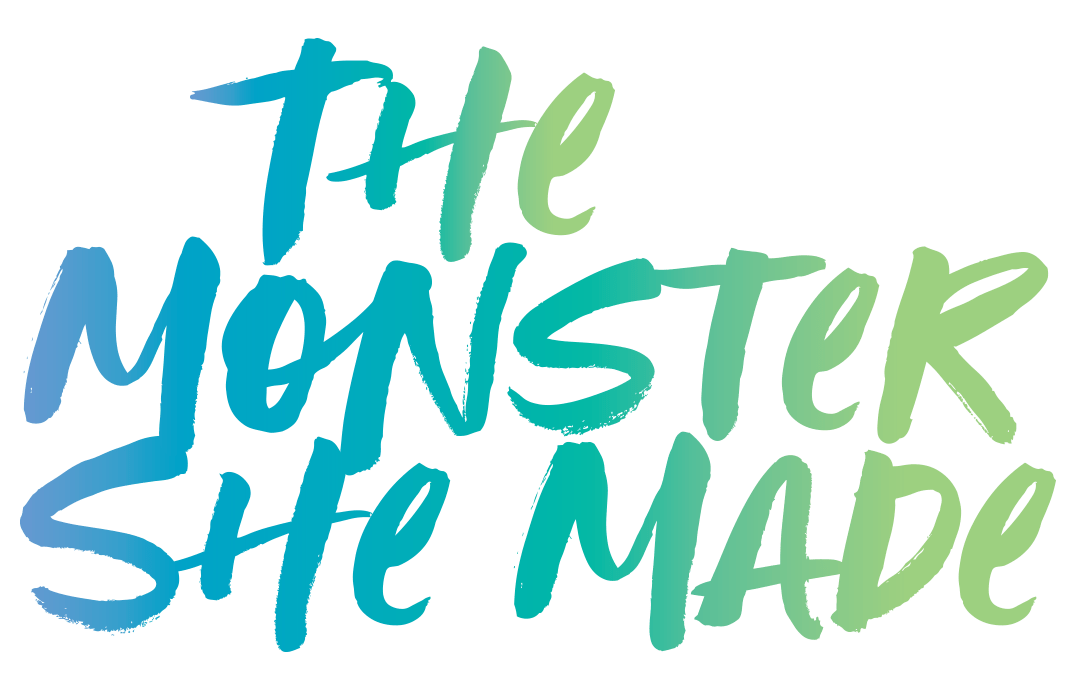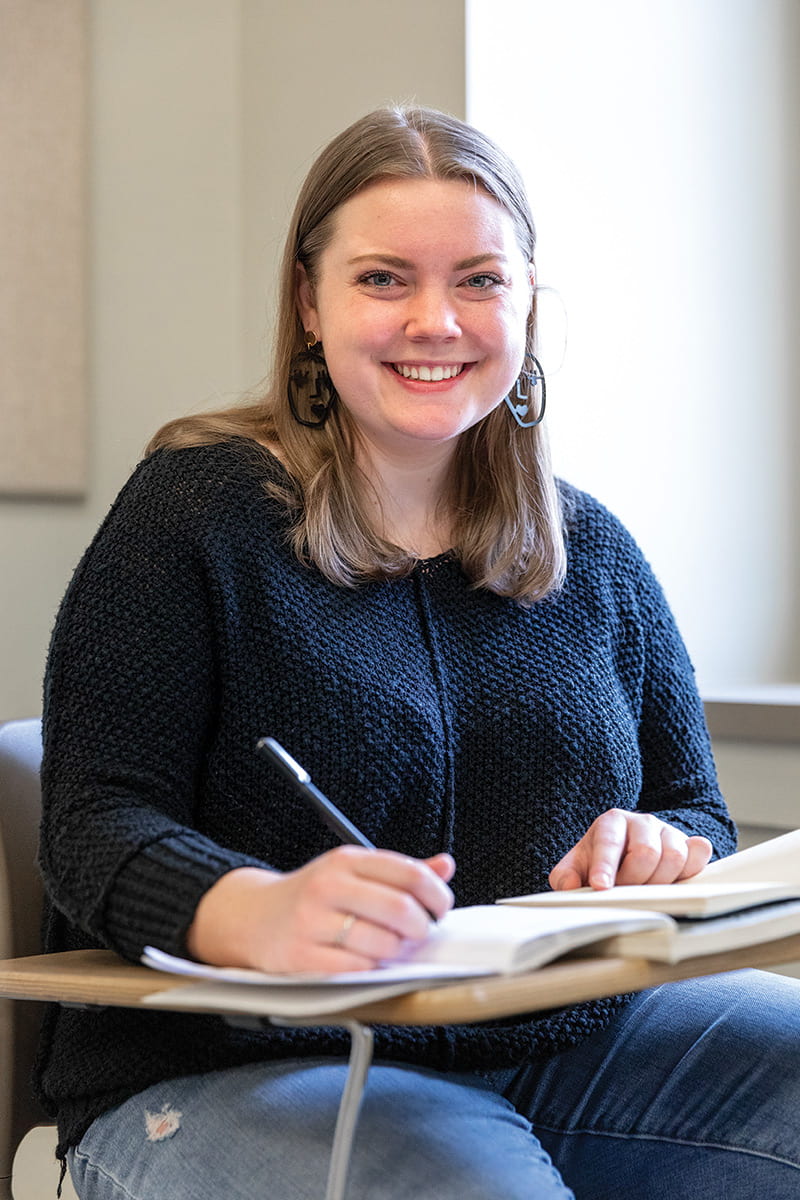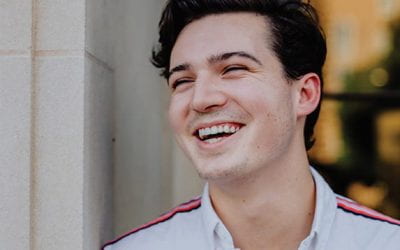
Image: Leigh Caruthers Prassel

By Hiba Tahir
Photos by Chieko Hara
When a family member was diagnosed with Ewing’s sarcoma, a rare form of bone cancer, Morgan Walker, an English major from Prairie Grove, saw many similarities between the grim prognosis and the plight of Victor Frankenstein, the eponymous scientist at the center of Mary Shelley’s renowned work.
At the time, Walker was taking Professor Lissette Szwydky-Davis’ class on adaptations of Frankenstein, during which she saw how widely the work had been reinterpreted in the two centuries since its publication. She set out to write her own adaptation, a “modern-day cancer narrative” in which a character based on Victor becomes the cancer patient, and the creature becomes her tumor. “I wanted to explore that creator-to-creature relationship,” Walker explained. “Just as Victor Frankenstein faces mental, physical and emotional turmoil because of something he created, so does the cancer patient with something they’ve created.”
She wanted to use a medium that would allow her to easily convey both the voice of the cancer patient and the voice of the tumor. “I realized poetry was the easiest form to convey those two different voices,” she said. She set out to write a collection comprised of two sections and titled it The Monster I Made and Other Poems. “In the first half, the speaker is a cancer patient creating a monster with a cancerous tumor,” she explained. “But then that title translates to the second half of my thesis, when I was writing from my own perspective, as well.”
Because Walker considers herself a “very structurally minded person,” the sestina, a usually unrhymed French verse form consisting of six stanzas of six lines each and a three-line envoy, or summation, appealed to her. “I remember being introduced to this concept and learning about the pattern and how it changes and being super drawn to it,” she said. “I wanted a form that I could manipulate.”
“there were more days I was meant to live.”

She filled the beginning of the first section with variations of the sestina form and used it to mimic the cancer patient’s life before and during diagnosis. “You see the first poem is a perfect sestina,” Walker pointed out. “It’s following all the rules. The patient is just living her everyday life, but then as we get further into the sequence of poetry and she deals with her diagnosis and goes into treatment, we see the sestina breaking rules and the structure begins to crumble.” Walker said that the change in form mimics the loss of control the speaker is feeling in the wake of diagnosis. The continued but altered repetition conveys a cyclical feeling not unlike the one felt in the progression of a disease.
Next, the manuscript delves into what Walker calls “the tumor section,” where the poems mimic patterns of growth experienced by the creature in Mary Shelley’s Frankenstein. “So the creature is emerging into this consciousness in the novel, and then he becomes this very well-spoken philosophical being,” she explained. “To mimic that with poetry and form, I began with very crude mechanical grammar. Very little punctuation.” This is evident in the poem “Abnormality”:
i abnormal
mismatch of matter
two chromosomes glitched i emerged
After this brief section of free verse, Walker included a contrapuntal, or a poem composed of multiple poems in columns that can be read separately or together from left to right. “You feel form coming in and playing a part, to mimic the tumor’s growing consciousness,” she explained. “Even the use of white space on the page shows the tumor spreading. It’s not just in one column; it’s in two.”
After the contrapuntal, the next few poems move into syllabic verse. “So that means each line has a certain number of syllables, and again, this is just to indicate that the tumor is a growing presence,” she explained. “It’s getting smarter, more intellectual.” For example, here’s the first stanza in “Relapse,” a poem with ten syllables in each line:
You did eliminate me for a month.
One round of scans suggested my absence.
In your confidence, you could breathe again,
hoping that my haunting hour had ceased.
Expectant that I disappeared for good,
you naively believed me to be gone.
In the final part of the first section, the speaker returns to free verse and the cancer patient’s perspective. “She’s abandoned the sestina and she’s taken back control in a new way,” Walker said. “She’s abandoned the old pattern of life and has emerged into this new style, which is open verse. She’s defeated her cancer and is moving forward with permission.” This is evident in the poem “Limb(s)”:
And I realized
(my creation did not control me)
((my body could still carry me))
(((my family would have me a little longer)))
there were more days I was meant to live.
More Field Notes
Goodwill Job Hunting
By Katie Wilson PowellPhotos by Chieko Hara For Jimmy Donlon, a senior marketing and management major and Honors College fellow, serving the community has meant being a part of the community throughout his entire life. Donlon’s father, a physician, founded a network...
Love Your Back? Take a Break!
By Hiba TahirPhotos by Russell Cothren Sitting down may be hazardous to your health. Those who spend several hours a day in seated positions — which, in the last year or two, is most of us, thanks to the COVID-19 pandemic — may find themselves struggling with lower...
Power Plays
By Kendall CurleePhotos by Beau Burris“The grand scale of both Versailles and D.C., built to awe and impress, gets the job done.”Washington, D.C. Satellite imagery © Google Earth Versailles, France. Satellite imagery © Google Earth Beau Burris has been obsessed with...
Prime Time for Gene Editing
Mary Jia searches for bacteria colonies that contain the plasmid needed to construct the gene-editing tool she’s designingBy Katie Wilson PowellPhotos by Chieko Hara Mary Jia, a biomedical engineering junior and Bodenhamer Fellow, has had her sights set on CRISPR...
Conscious Couture
By Hiba TahirPhotos by Hiba Tahir and Chieko Hara With normalcy beginning to return after months spent working from home, mostly in sweatpants, many are itching to refresh their wardrobes. Before you whip out your card for the latest trends, though, consider this:...
“There’s definitely some symbolism in the parenthetical multiplication,” Walker explained. “The speaker recognizes multiple implications that accompany her journey of healing. Each implication intensifies as the stanza progresses, thus requiring an additional bracket.”
In section two, Walker herself becomes the speaker — an irony that isn’t lost on her — and begins to reflect on real-life events following her family member’s diagnosis. “Artists are definitely the creators of their creatures,” she said. She uses several forms — sestinas, sonnets, free verse, and prose — to build her narrative, a move that she feels confident making.
“Form really is the most significant part of poetry,” she said. “It allows you to take on different voices. You get to mimic what’s happening in your content and the feelings that you’re trying to express.”






